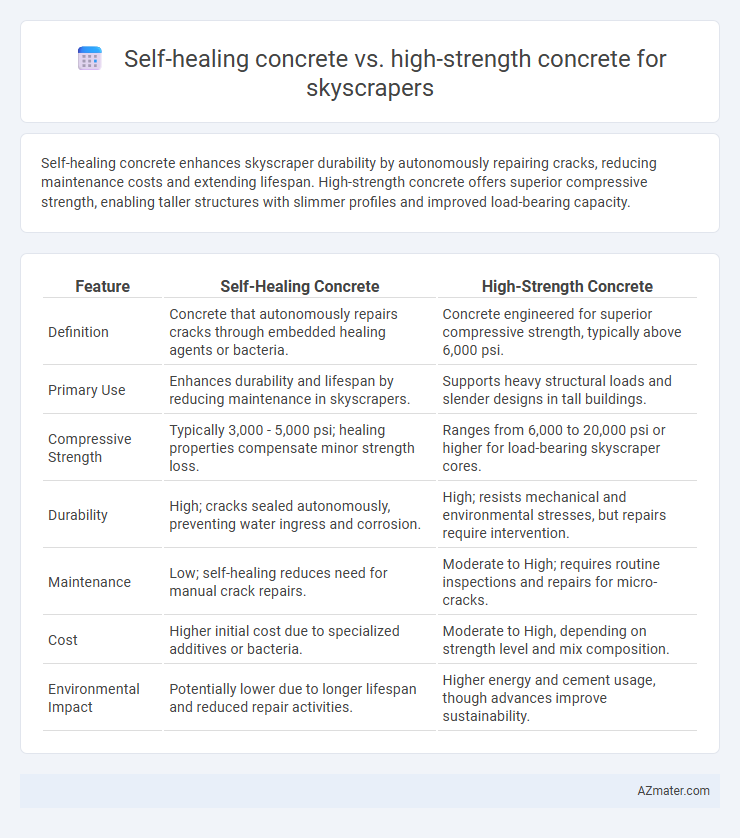Self-healing concrete enhances skyscraper durability by autonomously repairing cracks, reducing maintenance costs and extending lifespan. High-strength concrete offers superior compressive strength, enabling taller structures with slimmer profiles and improved load-bearing capacity.
Table of Comparison
| Feature | Self-Healing Concrete | High-Strength Concrete |
|---|---|---|
| Definition | Concrete that autonomously repairs cracks through embedded healing agents or bacteria. | Concrete engineered for superior compressive strength, typically above 6,000 psi. |
| Primary Use | Enhances durability and lifespan by reducing maintenance in skyscrapers. | Supports heavy structural loads and slender designs in tall buildings. |
| Compressive Strength | Typically 3,000 - 5,000 psi; healing properties compensate minor strength loss. | Ranges from 6,000 to 20,000 psi or higher for load-bearing skyscraper cores. |
| Durability | High; cracks sealed autonomously, preventing water ingress and corrosion. | High; resists mechanical and environmental stresses, but repairs require intervention. |
| Maintenance | Low; self-healing reduces need for manual crack repairs. | Moderate to High; requires routine inspections and repairs for micro-cracks. |
| Cost | Higher initial cost due to specialized additives or bacteria. | Moderate to High, depending on strength level and mix composition. |
| Environmental Impact | Potentially lower due to longer lifespan and reduced repair activities. | Higher energy and cement usage, though advances improve sustainability. |
Introduction to Self-Healing and High-Strength Concrete
Self-healing concrete incorporates microcapsules or bacteria that activate upon crack formation, enabling autonomous repair and enhanced durability in skyscraper structures. High-strength concrete, often achieving compressive strengths above 70 MPa, provides exceptional load-bearing capacity essential for the vertical demands of skyscrapers. The integration of self-healing properties reduces maintenance costs and extends service life, while high-strength concrete ensures structural integrity under extreme stress conditions.
Key Properties and Composition Differences
Self-healing concrete incorporates microcapsules or bacteria that activate upon crack formation, promoting autonomous repair and enhancing durability, whereas high-strength concrete relies on a dense matrix of cement, silica fume, and superplasticizers to achieve compressive strengths exceeding 70 MPa essential for load-bearing skyscraper structures. The composition of self-healing concrete includes healing agents like calcium carbonate-producing bacteria or polymeric microcapsules integrated within the cementitious matrix, contrasting with high-strength concrete's optimized aggregate grading and reduced water-to-cement ratio for maximum structural performance. Key properties of self-healing concrete emphasize crack resistance and longevity under dynamic stresses, while high-strength concrete prioritizes mechanical strength, stiffness, and resistance to deformation under extreme loads common in tall building applications.
Performance in Skyscraper Structures
Self-healing concrete enhances skyscraper performance by autonomously repairing microcracks, prolonging structural integrity and reducing maintenance costs. High-strength concrete, characterized by compressive strength often exceeding 70 MPa, supports taller skyscrapers by bearing extreme loads and minimizing column sizes. Integrating self-healing properties in high-strength formulations optimizes durability and reliability under the dynamic stresses encountered in skyscraper environments.
Durability and Longevity of Both Materials
Self-healing concrete enhances skyscraper durability by autonomously repairing micro-cracks, significantly extending structural lifespan and reducing maintenance costs. High-strength concrete offers superior load-bearing capacity, ensuring stability under extreme stress but lacks intrinsic self-repair capabilities, potentially leading to earlier degradation. Combining self-healing properties with high-strength formulations maximizes longevity, optimizing both structural integrity and resilience against environmental damage.
Crack Resistance and Repair Mechanisms
Self-healing concrete incorporates microcapsules or bacteria that activate upon crack formation, enabling autonomous crack repair and enhancing long-term durability in skyscraper structures. High-strength concrete provides superior compressive strength but remains susceptible to micro-cracks that require external repair interventions. The self-healing mechanism significantly reduces maintenance costs and extends structural service life by continuously addressing crack propagation without manual repair.
Cost-Benefit Analysis for Skyscraper Projects
Self-healing concrete reduces maintenance costs and extends the lifespan of skyscrapers by autonomously repairing cracks, leading to long-term savings despite higher initial material expenses. High-strength concrete offers superior load-bearing capacity crucial for skyscraper stability, often reducing structural volume and associated material costs. A cost-benefit analysis reveals self-healing concrete's higher upfront cost is offset by lower repair and downtime costs, while high-strength concrete optimizes construction efficiency and materials, making the choice project-specific based on durability versus initial budget priorities.
Sustainability and Environmental Impact
Self-healing concrete reduces maintenance costs and extends the lifespan of skyscraper structures by autonomously repairing cracks, thereby minimizing resource consumption and waste. High-strength concrete, while providing superior load-bearing capacity, often requires higher cement content, leading to increased carbon emissions during production. Incorporating self-healing technologies enhances sustainability by lowering lifecycle carbon footprints and promoting long-term structural resilience compared to conventional high-strength concrete.
Construction Challenges and Practical Considerations
Self-healing concrete reduces long-term maintenance by autonomously sealing cracks, addressing durability challenges in skyscraper construction but requires specialized materials and higher initial costs. High-strength concrete offers superior load-bearing capacity and faster construction cycles, yet demands precise mixing and curing practices to prevent brittleness and ensure structural integrity. Engineers must balance the innovative benefits of self-healing properties against the proven reliability and material availability of high-strength concrete when selecting materials for skyscraper projects.
Recent Innovations and Case Studies
Self-healing concrete incorporates microcapsules or bacteria that autonomously repair cracks, enhancing durability and reducing maintenance for skyscrapers exposed to extreme environmental stress. High-strength concrete, characterized by compressive strengths exceeding 10,000 psi, supports taller structures with superior load-bearing capacity and improved seismic resistance. Recent innovations like bacterial self-healing agents in Dubai's Burj Khalifa extension and ultra-high-performance concrete used in Shanghai Tower demonstrate the practical integration of these advanced materials in modern skyscraper construction.
Choosing the Right Concrete for Skyscraper Construction
Self-healing concrete offers enhanced durability by autonomously repairing cracks, reducing maintenance costs over a skyscraper's lifespan, while high-strength concrete provides exceptional compressive strength essential for supporting immense vertical loads. Selecting the right concrete involves balancing structural requirements, long-term performance, and lifecycle costs; high-strength concrete suits core load-bearing elements, whereas self-healing concrete benefits facade and exposed components prone to environmental damage. Integration of both types can optimize skyscraper resilience, ensuring structural integrity and sustainability in demanding urban environments.

Infographic: Self-healing concrete vs High-strength concrete for Skyscraper
 azmater.com
azmater.com